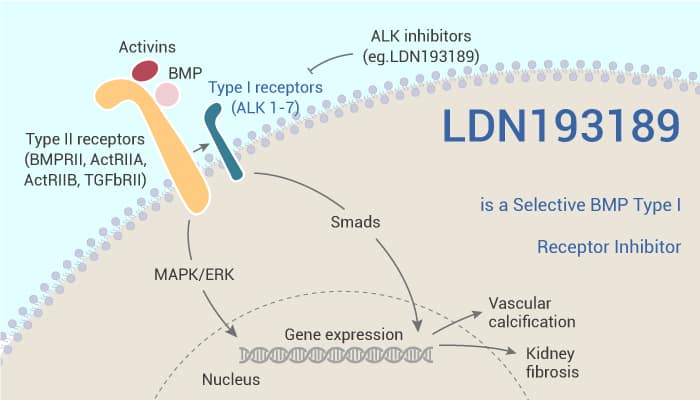Fibrodysplasia ossificans progressiva (FOP) is a congenital disorder of progressive. It is widespread postnatal ossification of soft tissues and is without known effective treatments. A recent study identified heterozygous mutations in ACVR1, the gene encoding the BMP type I receptor ALK2, in all affected members from seven families. BMP ligands facilitate the phosphorylation and activation of BMP type I receptors (ALK2, ALK3, and ALK6) by BMP type II receptors (BMPRII, ActRIIA, and ActRIIB). Activated BMP type I receptors phosphorylate BMP-responsive SMAD1, SMAD5, and SMAD8. They translocate to the nucleus to regulate the transcription of genes, including the Inhibitor of DNA binding (ID) gene family. They also show broad effects on growth and differentiation. LDN-193189 is a selective inhibitor of BMP type I receptor kinases. It inhibits activation of the BMP signaling effectors SMAD1, SMAD5, and SMAD8 in tissues expressing caALK2 induced by adenovirus specifying Cre (Ad.Cre).

LDN193189 is a selective BMP type I receptor inhibitor.
LDN193189 is a selective BMP type I receptor inhibitor. It efficiently inhibits ALK2 and ALK3 (IC50=5 nM and 30 nM, respectively). Moreover, it displays weaker effects on ALK4, ALK5, and ALK7 (IC50≥500 nM). It inhibits BMP4-mediated Smad1, Smad5, and Smad8 activation. In addition, LDN193189 also retains 200-fold selectivity for BMP signaling versus TGF-β signaling (IC50 for TGF-β ≥1,000 nM). LDN193189 increases selectivity for BMP signaling versus AMP-activated protein kinase, PDGFR, and MAPK signaling pathways. Moreover, it blocks the transcriptional activity induced by either constitutively active ALK2R206H or ALK2Q207D mutant proteins. In fact, LDN193189 inhibits the induction of alkaline phosphatase activity in C2C12 cells by BMP4 even when administered 12 h after BMP stimulation. Therefore, the sustained BMP signaling activity is needed for osteogenic differentiation.
In summary, LDN-193189 is a selective inhibitor of BMP type I receptor kinases. It can result in a reduction in ectopic ossification and functional impairment.
Reference:
Yu PB, et al.Nat Med, 2008, 14(12), 1363-1369.